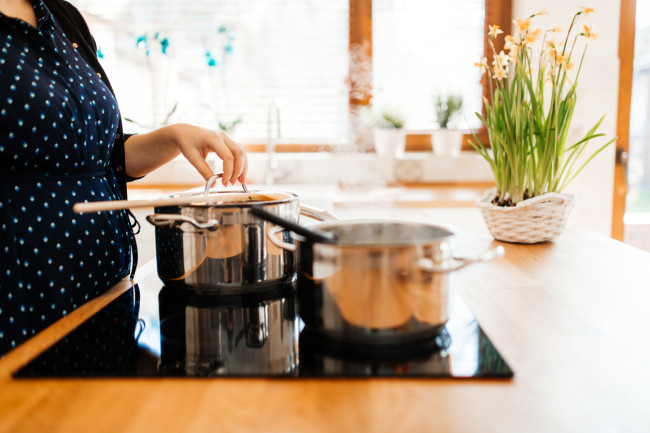Want the look of a wood-burning fire in your NYC apartment? Consider an electric or bio-fuel fireplace
- Plug-and-play electric fireplaces are easy to install, affordable, and warm though the flames are faux
- Bio-fuel models cost more and may require a build-out, but you get flickering, crackling flames
- Both options are clean alternatives to wood-burning fireplaces—and no chimney or vent is required

A HearthCabinet ventless fireplace, fueled by isopropyl gel, is an eco-friendly alternative to wood and gas fireplaces. The black firebox model in this Brooklyn residence is fabricated with small river stones in the interior. Design by OAD Interiors Project and NYC Professional Millwork.
Cozying up to a crackling fire in your apartment is just not a reality for most New Yorkers—wood-burning fireplaces are usually sealed or removed during renovations and banned in new construction developments. Environmental concerns about wood fireplace emissions contributing to indoor air pollution are also a big turn-off for many.
Even gas fireplaces, while still technically allowed, present distinct hassles in light of Local Law 152, which requires buildings to have their gas lines inspected every five years to prevent gas-related tragedies. And did you know that even though gas burns cleaner than wood, it can still pose a health risk (which is why you might want to consider giving up your gas stove).
Fortunately, there are safe, healthy, and eco-friendly ways to replicate the look, or at least the warmth, of a log fire in a New York City apartment for an especially appealing upgrade now that winter is here.
These electric and alternative-fuel fireplaces burn clean, avoiding the need for chimneys, flues, or vents. They require much less maintenance, as there's no build-up of soot and ash. They even generate heat, though not nearly to the degree of a wood fire (think 5,000 versus 50,000 BTUs). Most models can even be controlled via wifi, so you can arrive home to a roaring fire and program it to shut down after you've gone to sleep. Moreover, they come in many styles to match your design aesthetic, whether a traditional hearth setup or a modern, double-sided unit that can be shared by (or serve as a partition between) the kitchen and living area.
They come in a range of prices, too. On that note, be aware you'll generally need to hire a contractor to handle the installation work, the cost of which will vary with the job's complexity. Still, it will be substantially less than the cost of adding a gas fireplace, and because these fireplaces are not part of your permanent construction, they can be installed almost anywhere.
As with all construction, you will want to stay on the right side of your board by obtaining the necessary approvals according to your building's alteration agreement. An architect will know the drill. Otherwise, it's worth asking your property management company or super about the necessary protocol. Fireplace retailers are also generally used to providing specs to submit to boards to alleviate concerns about safety (and quality, as counterfeit versions exist).
[Editor's note: An earlier version of this post was previously published in December 2020. We are presenting it with updated information for December 2024.]
Ordering can take as little as one week for in-stock models and up to eight to 10 weeks for the rest, with customized fireplaces potentially taking longer.
Read on for Brick Underground's roundup of fireplace alternatives, including pros, cons, pricing, and examples. Your best bet is to see the different options in real-time, as photographs cannot truly capture the flickering flames. The retailers interviewed here have showrooms in the five boroughs.
Electric fireplaces
There are two types of electric fireplaces: one that uses LED bulbs to give the illusion of a flame and another that relies on a combination of LED and water vapor (or mist technology) to simulate flames and smoke. According to Sal Finocchiaro, a partner at NYC Fireplaces and Outdoor Kitchens, which has a showroom in Maspeth, Queens, electric fireplaces are a budget-friendly option, though not everyone is sold on them.
Pros: These plug-and-play models are basically electric heaters disguised as fireplaces, meaning they can be a significant heat source and reduce your heating bills. Many options even allow you to create zones to control the heat, or you can shut off the heat entirely while still enjoying the visual glow—a big plus in often-overheated NYC apartments. On average, standard units produce 4,600 BTUs per hour, whereas built-in models that can be hardwired for 240 volts produce up to 8,900 BTUs.
Cons: You won't get a real flame, which may or may not be a deal-breaker. Finocchiaro says water vapor fireplaces tend to look more realistic than LED. You'll have to have an electric outlet nearby, and depending on how often you use the fireplace, you may see a slight spike in your electrical bill, though not by much (and you'll be saving on heating costs). Note: These won't work during a power outage.
Pricing: LED fireplaces can be as low as $1,000, and water vapor models start at around $2,500. Installation is relatively easy for LED models, which can be as shallow as four inches.
"You could conceivably insert one into an existing wall, but you never know what you'll find there, so it might be easier to build it out instead," Finocchiaro says. Water vapor units are around 14 inches deep and require a new wall.
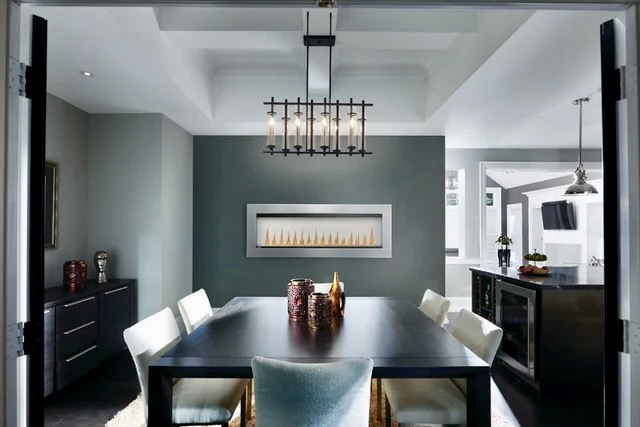
The see-through 60-inch Napoleon Clearion Elite is $2,909 and is shown here with a stainless steel surround. It is also available with a black surround or no surround.

For a water vapor option, Dimplex Opti-Myst offers a variety of standard widths. This 46-inch, built-in model is $5,399.
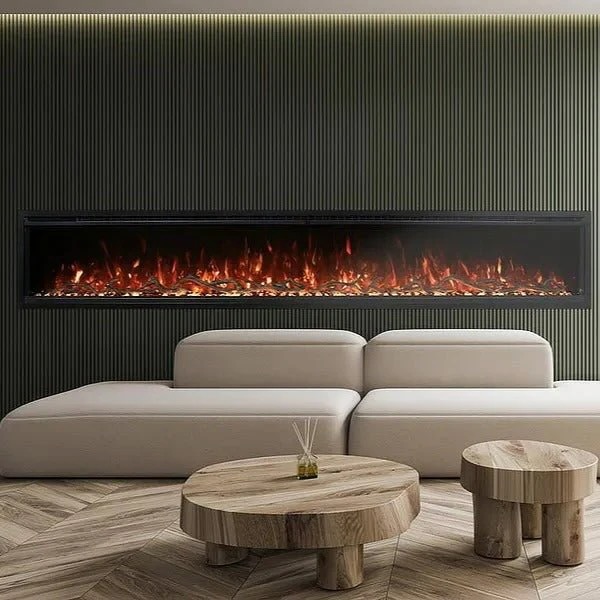
Wall-mounted options skip the need for opening up or building out a wall. The Modern Flames Spectrum Slimline 100-inch linear electric fireplace shown above retails for $2,699.
There are even wall-mounted models (like this one for $999, currently on sale for $549) for outdoor use, in case you have a terrace or patio.
Alternative-fuel fireplaces
Fireplaces fueled by alcohol (mainly ethanol and isopropyl) have been around for over a decade but have only caught on in the last few years as people switch from wood fireplaces. The fuel is kept in burners or canisters. "Imagine a chafing dish with a Sterno burner and you'll get the picture," says Sara Check, director of sales and marketing for HearthCabinet Ventless Fireplaces. The company's flagship showroom is in Chelsea.
Pros: "If people want the look of a real flame they'll go with an alcohol option," Finocchiaro says. Indeed, you get a real, flickering flame and even a crackling sound if you go with fireplaces that use fuel in a gel form, such as the ones by HearthCabinet. Ethanol and isopropyl alcohol are among the cleanest burning fuels, producing only water vapor and carbon dioxide (like your breath) and zero smoke or emissions. The biggest difference is that pure ethanol tends to create a bluer flame compared to the golden flame produced by isopropyl.
Cons: They have an average depth of 12 inches for single-sided models and 18 inches for multi-sided models, meaning you'll need construction work to house the boxes, though there's flexibility in where they can be installed. The cartridges only last for two hours, but are easily replaceable with new cartridges.
Pricing: These fireplaces range from $5,000 to $20,000 for standard models, depending on the size, finishes, and other variables. There's also the ongoing cost of the fuel replacement (see below), which you will want to factor into your decision. "For this reason alone, electric tends to be more budget-friendly," Finocchiaro says.
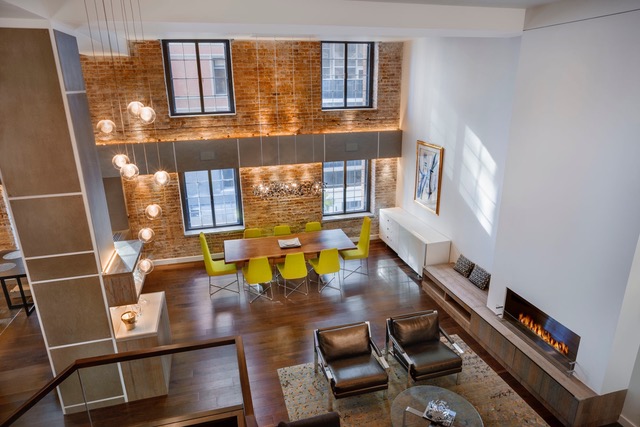
Jeff Streich, founder and principal of Prime Renovations, a renovation contractor in NYC, has had good experience with fireplaces from EcoSmart. The core of the EcoSmart fireplace is its reusable, washable burner; it also uses bio-ethanol, a sustainable form of ethanol derived from agricultural by-products (such as from grain and corn).
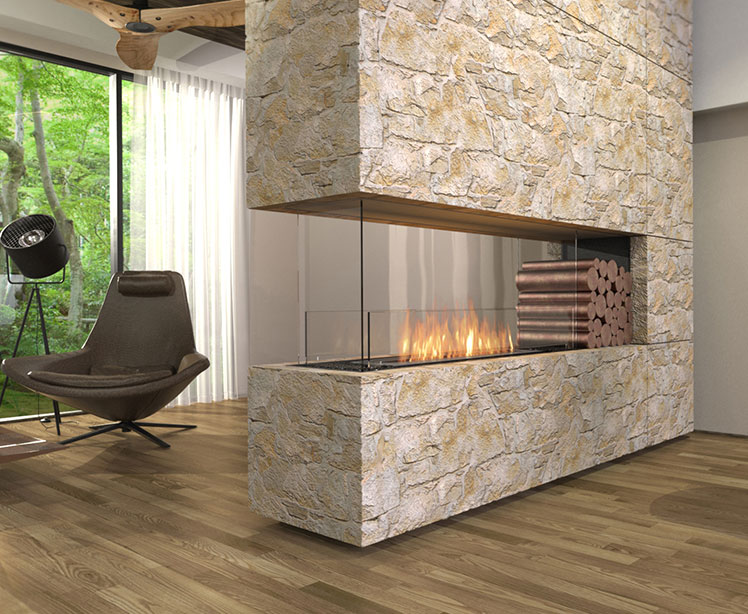
Finocchiaro sells several models of EcoSmart ethanol fireplaces. The Flex 104PN Peninsula model shown here is currently $13,195. Note that unlike the peninsula model (shown at top) by HearthCabinet, the flame here is shielded by glass but is otherwise open—an important consideration if you have children or pets.
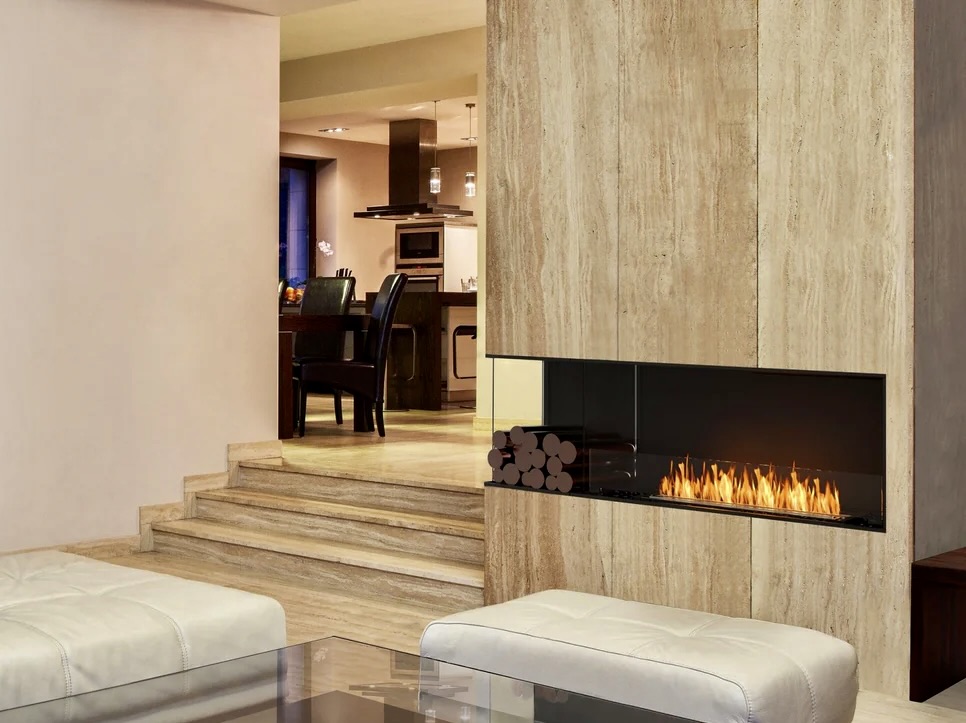
Or you can choose a wraparound version that is entirely enclosed, such as this EcoSmart 50LC.BXL Left Corner Flex model that retails for $6,595. It features a decorative box for storing the canisters and the "baby" XL500 burner that, though small in capacity, can heat over 440 square feet and deliver up to 13 hours of flame off a single refill.

If the idea of streaming flammable fuel into a (potentially hot) burner gives you pause, consider fireplaces by HearthCabinet, which rely on single-use canisters that are pre-filled with isopropyl gel—no pouring required.
"These are a key feature of our patented system, which includes either a standard or custom metal cabinet with a lockable top-hinged door and protective honeycomb metal screen so no one can touch the flame," Check says. (Per its website, the combination of its locked safety screen, single-use cartridges, insulation, and top-hinged key-locked door has garnered the company the only seal of approval by the NYC Fire Department and Department of Buildings.)
The standard cabinets come in a range of sizes and shapes, including square, tall, linear, horizon, panoramic, and widescreen, as we as multi-sided configurations and arched (the latest offering)—each with select interior and exterior finishes and decorative elements like riverstones, glass chips or beads, and ceramic spheres or logs.
HearthCabinet offers both retail and trade pricing, in case you are working with a pro. If not, Check says the company can connect you with contractors to do the installation and build-out.
All parts are fabricated locally and designed by staff architects and designers. The cabinet can slide into any surround, including a decorative piece of furniture, a traditional mantel, or a more elaborate construction (see photo at top). Because they require no hook-ups, these fireplaces do not require an extensive renovation for installation; Check says many clients do a sort of facelift, such as putting in millwork or re-envisioning the floor plan.
The cartridges are currently $12 each and sold in or cases of eight (about $100); an average of eight to 10 cases are needed to tide you through the colder months (November to March). They will either go out on their own or can be extinguished at any time by using the included snuffer plates.
Check says approvals for HearthCabinet ventless fireplaces from DOB and FDNY "state that there is no work permit needed and that the product is considered a decorative appliance. It is really important that people remember when talking to their board that HearthCabinet is not technically a fireplace."
In-stock units ship in two to three weeks, standard units with select options around eight weeks.
Fireplace conversions
If you happen to have an existing fireplace, sealed or not, you can easily convert it to one of the above methods. Check says HearthCabinet does a lot of these retrofits throughout NYC.
Streich converted a wood-burning fireplace for a client (above), who in addition to going with an ethanol model spent $5,000 on a mantel from Europe, adding rocks that sparkle when the fire is lit.
For a far easier and cheaper alternative, you could opt for a simulated burning log set, such as the Dimplex Revillusion 25-inch Plug-in Electric Set, which costs $660, kicks out over 5,000 BTUs of heat, and can be operated by remote control.
Cheaper still at $249 is the LegendFlame 23-inch Electric Fireplace Log Set (EF290), offering a crackling sound and 400 square feet of heat.
No-fireplace fireplace options
In an updated version of the old-school, televised flickering flame, complete with the covetable white birch logs, you can take a break from binge-watching your favorite shows and stream a faux fire in "crystal-clear, high-def" warmth on your smart TV.
You Might Also Like




















